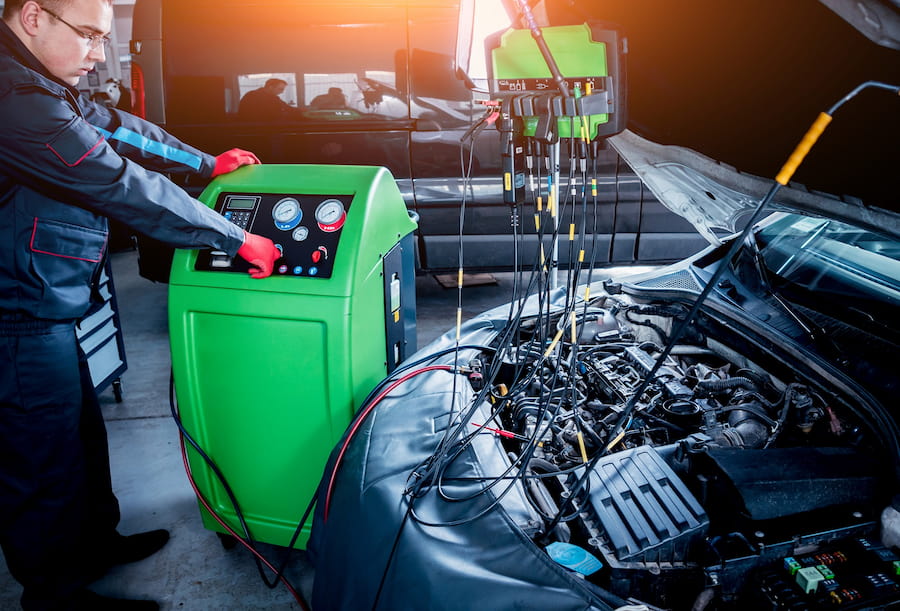Introduction:
It’s important to diagnose common automobile AC issues if you want to keep your car comfortable and functional, especially in the sweltering summertime. When the air conditioning system in your automobile breaks down, it may cause pain, decreased fuel efficiency, and even possible damage to other parts. In this thorough guide, we’ll take you step-by-step through the process of diagnosing and fixing typical AC issues in cars. Please be aware that some problems may require professional knowledge; therefore, if you are unsure of your abilities, it is better to seek the advice of a competent technician.
Car air conditioning recharging is a process that replenishes the refrigerant in the AC system, improving its cooling efficiency and ensuring optimal performance during hot weather conditions.
How To Diagnose Common Car AC Problems?
Insufficient Cooling:
Check the Refrigerant Levels:
Insufficient cooling might result from low refrigerant levels. Make that the system’s pressure is within the manufacturer’s recommended range by measuring it using a pressure gauge. Before recharging the system, a leak may exist if the pressure is too low and needs to be fixed.
Find Visible Leaks:
Check the compressor, hoses, fittings, and other parts of the AC system for any obvious indications of refrigerant leaks. Leaks may be indicated by stains or oil residue close to connections and components.
Compressor clutch testing:
Activate the AC and start the car. Verify whether the compressor clutch engages whenever the AC is turned on. If not, it can be an electrical problem, defective clutch, or relay.
No Cold Air:
Verify compressor engagement:
When the air conditioner is turned on, check to see if the compressor clutch engages and disengages as it should. If not, there can be an issue with the compressor or electrical parts.
A fuse or relay may have blown.
Examine the fuses and relays that are connected to the AC system. The AC might not be operating correctly due to a blown fuse or a defective relay.
Take a look at the orifice tube or expansion valve:
There may not be any cold air because of a refrigerant flow obstruction, such as a clogged or broken expansion valve or orifice tube.
Unpleasant Odors:
If there are offensive odors, look for mold or mildew.
Mold or mildew development inside the air conditioning system is a common source of musty odors. To get rid of smells, purify or substitute the cabin air filter and use an AC cleaner.
Check for debris:
Debris accumulation in the system can lead to unpleasant odors from leaves, dust, or other items. Regularly inspect and clean the cabin air filter and air intake.
Rapidly On/Off AC Cycling (Short Cycling):
Check the levels of refrigerant:
Short cycling of the AC compressor might result from low refrigerant levels. Inspect the system for leaks and recharge it if necessary.
Look over the pressure switches:
Short cycling may be caused by faulty high- or low-pressure switches. If required, test them and replace them.

Unusual Noises:
Listen for compressor noises:
Mold or mildew growth in the air conditioning system is a common source of musty odors. To get rid of smells, clean or replace the cabin air filter and use an AC cleaner.
Check for debris:
Debris accumulation in the system can lead to unpleasant odors from leaves, dust, or other items. Regularly inspect and clean the cabin air filter and air intake.
Warm Air on One Side and Cold Air on the Other (Dual Zone AC):
Check the blend door actuator:
Dual-zone AC systems have blend door actuators that control air distribution. Malfunctioning actuators can cause temperature imbalances.
Inspect the temperature sensors:
Faulty temperature sensors can misread cabin temperature, affecting the dual-zone AC’s performance.
AC System Leaks:
Use a UV dye:
Add a UV dye to the AC system, run the AC for a while, and then use a UV light to spot the dye at the source of the leak.
Perform a visual inspection:
Look for oily residue or stains around AC components as an indication of leaks.
Compressor Clutch Not Engaging:
Check the compressor clutch relay:
A faulty relay can prevent the compressor clutch from engaging. Test and replace if necessary.
Inspect the electrical connections:
Loose or damaged electrical connections can also cause the compressor clutch not to engage.
Seek Professional Assistance:
It is preferable to see a qualified mechanic or an automotive AC specialist if the diagnosis procedure fails to identify the problem or if you lack the required equipment and knowledge.
This thorough guide will help you identify typical AC issues in cars and take the necessary action to fix them. Keep in mind that early repairs and routine maintenance can increase the lifespan of your car’s air conditioning system and guarantee a comfortable ride, particularly in hot weather.
Last words:
Keep in mind that working with vehicle AC systems involves handling potentially dangerous compounds like refrigerants, therefore appropriate safety measures and understanding are crucial. It is best to obtain expert advice from a licensed mechanic or AC specialist if you are unsure about any element of the diagnosis or repair. Your car’s air conditioning system may be kept operating efficiently with routine maintenance and timely response to problems, resulting in a comfortable and enjoyable driving experience regardless of the weather.
Also, read: Plugged In and Powered Up: The Global Race to Electric Vehicle Dominance


